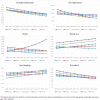Trends of Racial/Ethnic Differences in Emergency Department Care Outcomes Among Adults in the United States From 2005 to 2016
- PMID: 32671081
- PMCID: PMC7330111
- DOI: 10.3389/fmed.2020.00300
Trends of Racial/Ethnic Differences in Emergency Department Care Outcomes Among Adults in the United States From 2005 to 2016
Abstract
Importance: While the literature documenting health disparities has advanced in recent decades, less is known about the pattern of racial/ethnic disparities in emergency care in the United States. Objective: To describe the trends and differences of health outcomes and resource utilization among racial/ethnic groups in US emergency care for adult patients over a 12-year period. Design, Setting, and Participants: This cross-sectional study of emergency department (ED) data from the nationally representative National Hospital Ambulatory Medical Survey (NHAMCS) examined multiple dimensions of ED care and treatment from 2005 to 2016 among adults in the US. Main Outcomes and Measures: The main outcomes include ED care outcomes (hospital admission, ICU admission, and death in the ED/hospital), resource utilization outcomes (medical imaging use, blood test, and procedure use), and patients' waiting time in the ED. The main exposure variable is race/ethnicity including white patients (non-Hispanic), black patients (non-Hispanic), Hispanic patients, Asian patients, and Other. Results: During the 12-year study period, NHAMCS collected data on 247,989 adult (> 18 years old) ED encounters, providing a weighted sample of 1,065,936,835 ED visits for analysis. Asian patients were 1.21 times more likely than white patients to be admitted to the hospital following an ED visit (aOR 1.21, 95% CI 1.12-1.31). Hispanic patients presented no significant difference in hospital admission following an ED visit (aOR 1.01, 95% CI 0.97-1.06) with white patients. Black patients were 7% less likely to receive an urgent ESI score than white patients less likely to receive immediate or emergent scores, as opposed to semi- or non-urgent scores. Black patients were also 10% less likely than white patients to be admitted to the hospital and were 1.26 times more likely than white patients to die in the ED or hospital. Conclusions and Relevance: Race is associated with significant differences in ED treatment and admission rates, which may represent disparities in emergency care. Hispanic and Asian Americans were equal or more likely to be admitted to the hospital compared to white patients. Black patients received lower triage scores and higher mortality rates. Further research is needed to understand the underlying causes and long-term health consequences of these disparities.
Keywords: African-American; emergency care; health disparities; health outcomes; resource utilization; trend.
Copyright © 2020 Zhang, Carabello, Hill, Bell, Stephenson and Mahajan.
Figures
Similar articles
-
Racial and Ethnic Disparities in Emergency Department Care and Health Outcomes Among Children in the United States.Front Pediatr. 2019 Dec 19;7:525. doi: 10.3389/fped.2019.00525. eCollection 2019. Front Pediatr. 2019. PMID: 31956644 Free PMC article.
-
Race and Ethnicity and Emergency Department Discharge Against Medical Advice.JAMA Netw Open. 2023 Nov 1;6(11):e2345437. doi: 10.1001/jamanetworkopen.2023.45437. JAMA Netw Open. 2023. PMID: 38015503 Free PMC article.
-
Association of the affordable care act with racial and ethnic disparities in uninsured emergency department utilization.BMC Health Serv Res. 2023 Nov 25;23(1):1302. doi: 10.1186/s12913-023-10168-5. BMC Health Serv Res. 2023. PMID: 38007468 Free PMC article.
-
Association of Race/Ethnicity With Emergency Department Destination of Emergency Medical Services Transport.JAMA Netw Open. 2019 Sep 4;2(9):e1910816. doi: 10.1001/jamanetworkopen.2019.10816. JAMA Netw Open. 2019. PMID: 31490537 Free PMC article.
-
Racial/Ethnic Differences in Emergency Department Utilization and Experience.J Gen Intern Med. 2022 Jan;37(1):49-56. doi: 10.1007/s11606-021-06738-0. Epub 2021 Apr 5. J Gen Intern Med. 2022. PMID: 33821410 Free PMC article.
Cited by
-
A Quality Framework to Address Racial and Ethnic Disparities in Emergency Department Care.Ann Emerg Med. 2023 Jan;81(1):47-56. doi: 10.1016/j.annemergmed.2022.08.010. Epub 2022 Oct 15. Ann Emerg Med. 2023. PMID: 36257864 Free PMC article.
-
Sociodemographic Disparities in 1-Year Outcomes of Children With Community-Acquired Acute Kidney Injury.JAMA Netw Open. 2024 Oct 1;7(10):e2440988. doi: 10.1001/jamanetworkopen.2024.40988. JAMA Netw Open. 2024. PMID: 39470639 Free PMC article.
-
Race and Ethnicity and Diagnostic Testing for Common Conditions in the Acute Care Setting.JAMA Netw Open. 2024 Aug 1;7(8):e2430306. doi: 10.1001/jamanetworkopen.2024.30306. JAMA Netw Open. 2024. PMID: 39190305 Free PMC article.
-
Epidemiology and outcomes of emergency department visits in systemic lupus erythematosus: Insights from the nationwide emergency department sample (NEDS).Lupus. 2023 Dec;32(14):1646-1655. doi: 10.1177/09612033231215381. Epub 2023 Nov 14. Lupus. 2023. PMID: 37961765 Free PMC article.
-
A bias evaluation checklist for predictive models and its pilot application for 30-day hospital readmission models.J Am Med Inform Assoc. 2022 Jul 12;29(8):1323-1333. doi: 10.1093/jamia/ocac065. J Am Med Inform Assoc. 2022. PMID: 35579328 Free PMC article.
References
-
- Smedley BD, Stith AY, Nelson AR. Unequal Treatment: Confronting Racial and Ethnic Disparities in Health Care. Washington, DC: National Academies Press; (2002). - PubMed
-
- Committee on Understanding and Eliminating Racial and Ethnic Disparities in Health Care, Board on Health Sciences Policy Staff, Institute of Medicine (IOM) Staff Introduction and Literature Review. In: Smedley BD, Stith AY, Nelson AR. editors. Unequal Treatment: Confronting Racial and Ethnic Disparities in Health Care. Washington, DC: National Academies Press; (2002). p. 29. - PubMed
-
- Collins KS, Hall A, Neuhaus C. U.S. Minority Health: A Chartbook. New York, NY: The Commonwealth Fund; (1999).
Grants and funding
LinkOut - more resources
Full Text Sources


